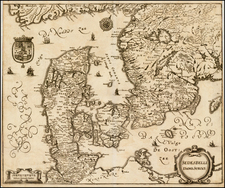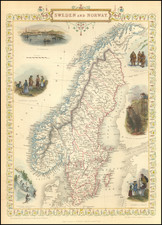Rare 1801 folding map of Uppsala region of Southeastern Sweden, immediately north of Stockholm.
The map shows administrative divisions; lakes and other bodies of water shown by hachures.
The map is part of a landmark set of modern maps created by Samuel Gustaf Hermelin and Carl Peter Hällstöm between 1799 and 1818.
Samuel Gustaf Hermelin was a Swedish industrialist, diplomat, and mapmaker. He was part of the Swedish nobility.
Hermelin was born on April 4, 1744, in Stockholm, Sweden, and died there on March 4, 1820. He was the son of Carl Hermelin, a member of the council of state, and Hedvig Ulrika Benzelstierna. He was educated at Uppsala University, starting September 27, 1760, and later worked in various positions related to mining and chemistry. Hermelin married twice: first to Maria Elisabet Sandels in 1773, who died in 1779, and then to Hedvig Augusta af Söderling in 1785, who died in 1794.
By the age of 17, Hermelin had completed the necessary studies to enter the mining college, where he began as an observer in 1761. He deepened his knowledge in the laboratory and spent years conducting geological field studies and metallurgical experiments. In 1764, he experimented with copper smelting at Åtvidaberg and later, with coal minerals in Skåne. He traveled to Norway in 1768 to study its geology and mining industries. Hermelin received a scholarship in 1769 to visit Sweden's mining sites, focusing on the quality of copper and introducing new methods to improve it. In the 1770s, he became a partner in an industry processing pyrite from mines.
In 1782, King Gustav III sent him to North America to study geology and promote Swedish trade interests. Despite carrying a ministerial letter, his mission remained discreet due to Sweden's relations with England. Hermelin was well-received in America, inducted into the Cincinnatus Order, and extended his stay due to illness. His return trip included studies in Germany, the Netherlands, France, and England.
Hermelin opposed the absolute monarchy in Sweden and was involved in the political opposition. He was questioned for his potential involvement in the 1792 assassination of Gustav III but denied all connections and allegedly avoided trial by bribing a police chief.
Hermelin was instrumental in promoting the use of Sweden's natural resources, leading to his extensive travels and the production of geographical maps. The Hermelin atlas, published from 1796 to 1818, marked a significant phase in Swedish cartography, although Hermelin faced financial losses from this project.
Later, he attempted to develop the iron industry in Norrbotten but faced several setbacks, including natural disasters and the war of 1809, which ultimately led to his bankruptcy in 1812. Despite this, the Swedish parliament granted him an annual pension for his geographical contributions from 1818.
In 1784, Hermelin became a Foreign Honorary Member of the American Academy of Arts and Sciences. He also joined the American Philosophical Society in Philadelphia as an international member in 1785.
Carl Peter Hällstöm was born on February 27, 1774, in Ilmola, Finland, and passed away on March 13, 1836, in Stockholm, Sweden. He was a distinguished Swedish cartographer and the brother of Gustaf Gabriel Hällström.
In 1792, Hällstöm began his academic pursuits at Åbo, attaining his master's degree in philosophy in 1795. Subsequently, he joined the Bergskollegium, where he became a geschworner in 1797. Around the same time, he was appointed as a tutor in the household of Samuel Gustaf Hermelin, who assigned him to gather materials and conduct measurements for a comprehensive mapping project of Sweden and Finland.
From 1799 to 1818, Hällstöm produced an exemplary series of maps covering various regions of the kingdom. He published his foundational geodetic work in the Royal Swedish Academy of Sciences and in his notable publications, such as "Geographical Determinations" (1804-15), "Listing of Geographical Latitudes and Longitudes in Vesterbotten's Chiefdom" (1803), and "Listing of Places’ Geographical Latitudes and Longitudes in Sweden" (1818). Additionally, he crafted numerous maps for individual projects, notably contributing to Anders Fredrik Skjöldebrand's "Voyage pittoresque au Cap Nord" and Vilhelm Fredrik Palmblad's "Palæstina."
In 1801, Hällstöm transitioned to the Lantmäterikontoret, was appointed as the head of the nautical chart archive in 1809, and concurrently became a member of the stream clearance committee. In this capacity, from 1819 to 1831, he examined and assessed nearly all major watercourses, streams, and falls from Norrbotten to Skåne and Blekinge. He developed plans and cost estimates for lake lowering, stream clearings, harbour constructions, and carried out triangulation measurements and hydrographic surveys along the nation's coasts. Following the dissolution of the stream clearance committee, Hällstöm was appointed as the head of the Northern Canal District in 1827 and was promoted to head of the expeditions' office in 1830, having been granted the rank of lieutenant colonel in 1826.
Hällstöm was elected as a member of the Royal Swedish Academy of Sciences in 1804, which posthumously honored him with a medal in 1841.









![[Denmark and Southern Sweden] Danorum Marca, vel Cimbricum, aut Daniae Regnum . . . M. D. LXXXV.](https://storage.googleapis.com/raremaps/img/small/91201.jpg)
![[ Baltic Sea / Sweden / Poland / Rugen ] De Custen van Denemarcken en Sweden, van Valsterbon tot Schenkenes, als mede de cust vanten van Pomeren van't eylant Rugen tot Rygshooft . . .](https://storage.googleapis.com/raremaps/img/small/99944.jpg)


![[Swedish Cities] Charta ofwer Upstaden Wadstena No. XLVIII [with] Charta ofwer Upstaden Skeninge No. XLIX.](https://storage.googleapis.com/raremaps/img/small/70095.jpg)
![[Map of Sweden and Norway] Карта Швеціи и Норвегіи](https://storage.googleapis.com/raremaps/img/small/66784.jpg)